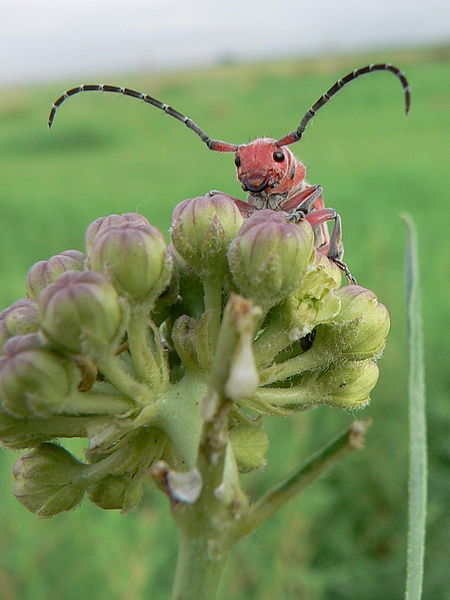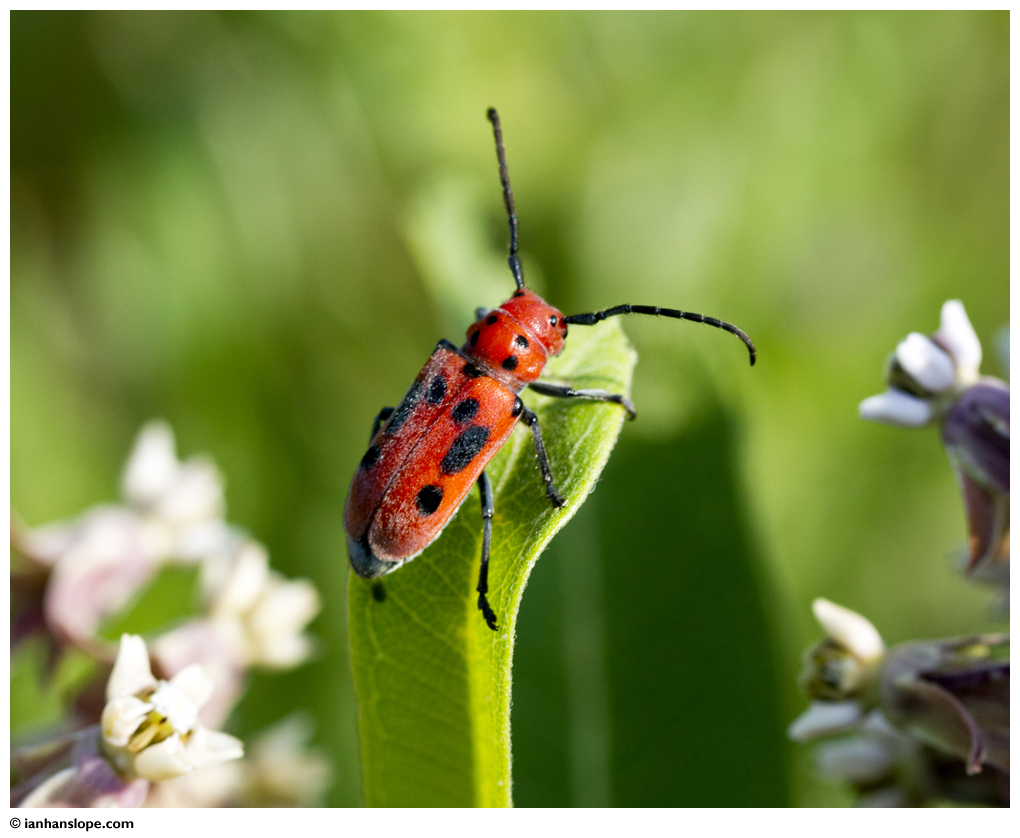Interactions
 The Red Milkweed Beetle has a limited amount of interactions with
other organisms. This is mostly due to the fact that this arthropod
has a chemical defense, protecting it from most potential predators
in its environment. The most crucial interaction that
T. tetrophthalmus
has is with Asclepias syriaca,
the Common Milkweed plant (Lacourse, 1999). The Red Milkweed
Beetle uses the Common Milkweed plant as its source of nutrition and
shelter. Female beetles lay their eggs inside the stems of the plant
for protection and safekeeping until the larvae is ready to become
adults (Matter, 2009). As the young beetles grow throughout the fall
and winter months, they rely on the Common Milkweed plant’s
underground rhizomes to supply them with proper nutrients to
continue growing (Matter, 2009). This specific species of beetle
uses the A. syriaca as source of food throughout their whole lifetime.
They consume nearly every part of the plant, including flowers,
stems, and leaves. The Common Milkweed can only be consumed by a
handful of organisms because of a toxic chemical that resides within
the plant (Matter, 2009). The chemical is considered to be a cardiac
glycoside, which means that it can have adverse health effects upon
the heart of a potential predator (Lacourse, 1999). Since the Red
Milkweed Beetle primarily consumes the Common Milkweed plant, the
toxic chemical resides within the body of the beetle species. This
means that the T.
tetrophthalmus has a chemical defense against its predators,
thus resulting in low rates of predation.
The Red Milkweed Beetle has a limited amount of interactions with
other organisms. This is mostly due to the fact that this arthropod
has a chemical defense, protecting it from most potential predators
in its environment. The most crucial interaction that
T. tetrophthalmus
has is with Asclepias syriaca,
the Common Milkweed plant (Lacourse, 1999). The Red Milkweed
Beetle uses the Common Milkweed plant as its source of nutrition and
shelter. Female beetles lay their eggs inside the stems of the plant
for protection and safekeeping until the larvae is ready to become
adults (Matter, 2009). As the young beetles grow throughout the fall
and winter months, they rely on the Common Milkweed plant’s
underground rhizomes to supply them with proper nutrients to
continue growing (Matter, 2009). This specific species of beetle
uses the A. syriaca as source of food throughout their whole lifetime.
They consume nearly every part of the plant, including flowers,
stems, and leaves. The Common Milkweed can only be consumed by a
handful of organisms because of a toxic chemical that resides within
the plant (Matter, 2009). The chemical is considered to be a cardiac
glycoside, which means that it can have adverse health effects upon
the heart of a potential predator (Lacourse, 1999). Since the Red
Milkweed Beetle primarily consumes the Common Milkweed plant, the
toxic chemical resides within the body of the beetle species. This
means that the T.
tetrophthalmus has a chemical defense against its predators,
thus resulting in low rates of predation.
The
relationship between the Red Milkweed Beetle and the Common Milkweed
is mutualistic, so both organisms receive a benefit from the
relationship. During research studies, it has been proven that
A. syriaca thrives
in the presence of the Red Milkweed Beetle (Lacourse, 1999). The
plant species has a higher rate of growth and produces more
flowering structures when the
T. tetrophthalmus is living on and within the plant
(Lacourse, 1999).

As
mentioned earlier, the Red Milkweed Beetle has very few predators
due to the toxic chemicals residing within its body. The beetle is
only preyed upon by birds on accident (Lacourse, 1999). Certain bird
species may mistake the Red Milkweed Beetle for another species of
arthropod and mistakenly ingest it. The toxic chemical inside the
beetles also creates a vulgar taste in the mouth of a predator
attempting to eat it (Matter, 2009).
Now continue to the Gallery page!